U.S. Military, Veterans, Contractors & Allies

Service members involved in physical therapy at the Brooke Army Medical Center in San Antonio wait for President Bush to visit, Nov. 8, 2007. (AP Photo/Gerald Herbert)
During the post-9/11 wars from 2001-2021, between 1.9 and 3 million U.S. service members served in military operations in Afghanistan, Iraq, and related theaters, and over half of them deployed more than once. These men and women served longer tours of duty, had higher levels of exposure to combat, and suffered much higher rates of disability, than during any previous U.S. war. Many times that number of Americans have also borne the costs of war as spouses, parents, children, and friends cope with their loved ones’ absence, mourn their deaths, or care for the changed person who often returns.
Thousands of U.S. service members, military contractors, and allied military and police were killed in these wars. Foreign workers for U.S. contracting firms often do not have their deaths recorded or compensated.
Hundreds of thousands more U.S. and allied service members were wounded in combat and have died or been disabled as a result of injuries sustained in the war zones. Common combat injuries include second and third degree burns, broken bones, shrapnel wounds, brain injuries, spinal cord injuries, nerve damage, paralysis, loss of sight and hearing, post-traumatic stress disorder (PTSD), and limb loss. Toxic exposure from dust and burn pits have resulted in respiratory, cardiac, and neurological diseases. Post-9/11 war veterans have far higher rates of service-connected disabilities than veterans of previous wars.
The U.S. military suicide rate, historically low, climbed significantly after 2004, signaling a mental health crisis. Traumatic brain injury and PTSD are major issues among Iraq and Afghanistan veterans. In comparison to the civilian population, war veterans face elevated rates of mental health problems, drug and alcohol dependence, car crashes, and homelessness. They and their families also experience higher rates of divorce as well as homicide, child abuse, and child neglect by parents.
When service members return home injured, it is often their families who provide care. The military has increasingly off-loaded the burden of care for service members’ health onto their families and communities, and mainly onto female spouses and partners.
Over the past decade, the U.S. military has implemented policies to promote gender equality. Yet high rates of sexual assault and violent patterns of abuse continue within military workplaces. Experiences of gender inequality are most pronounced for women of color, who experience intersecting forms of racism and sexism and are one of the fastest-growing populations within the military. Independent data also confirm queer and trans service members’ disproportionately greater risk for sexual assault.
Key Findings
U.S. Military
- Over 7,053 U.S. service members died in the post-9/11 wars.
- At least four times as many U.S. service members and veterans of the post-9/11 wars died by suicide than in combat.
- Certain U.S. states and communities have borne a higher human cost than others, signaling a pattern of inequality in military service.
- On average, over the course of the war in Afghanistan (2001-2021), 24% of U.S. active-duty women service members and 1.9% of active-duty men experienced sexual assault. These numbers are two to four times higher than official DoD estimations of sexual assault prevalence in the military.
Contractors
- An estimated 8,189 contractors for the U.S. military died during the post-911 wars.
- Foreign workers for U.S. contracting firms often do not have their deaths recorded or compensated. Military contractor companies in Afghanistan routinely violate one of the only legal protections for these workers.
- The United States’ Special Immigrant Visa (SIV) Program was designed to help Afghans and Iraqis in danger as a result of their service to the U.S. government, yet processes are broken: it often fails to support those who need it most.
Allied Military and Police
- Over 178,346 national military and police from Afghanistan, Pakistan, Iraq, and Syria were killed in post-9/11 wars.
- U.S. allies, including the United Kingdom, Germany, France, Italy, and Canada as well as other nations, also contributed troops and suffered significant fatalities.
- 12,468 allied troops were killed in the post-9/11 wars between 2001-2023.
Veterans
- Over 1.8 million veterans have some degree of officially recognized disability as a result of the wars. Veterans of the post-9/11 wars account for more than half of the severely disabled veteran population.
- More than 40 percent of post-9/11 veterans – an extraordinarily high proportion – are entitled to lifetime disability payments, and this number is expected to increase to 54 percent over the next 30 years. By comparison, fewer than 25 percent of veterans from World War II, Korea, Vietnam and the first Gulf War have been certified as having a service-connected disability.
- The economic costs of caring for post-9/11 war vets will reach between $2.2 and $2.5 trillion by 2050.
- Other Than Honorable (OTH) discharges and other “bad papers” often result from minor forms of misconduct stemming from trauma sustained during military service. They prevent veterans from receiving Veterans Affairs (VA) healthcare, education and housing support, and other resources.
(Page updated as of June 2025)

